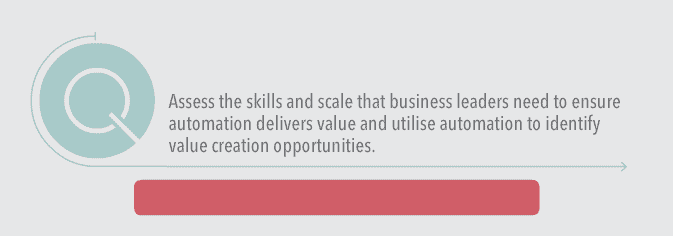Is there something your business needs to be doing today which you can’t do because it requires significant investment in headcount?
It could be something from a customer experience point of view, an organisational standpoint or even a compliance aspect that you need to be doing but it’s out of reach because you can’t bring on the headcount or sustain the large investment.
Now, tell me, what’s the cost to your business of not doing that activity? What’s the impact of you not doing something that needs to be done in the business?
Is it impacting your customer experience, brand experience or employee experience?
Does it mean you’re not achieving compliance or are facing greater risk?
New Zealand businesses need to adopt future-ready business models, to remain relevant and sustainable. It’s time to re-think how businesses operate – and the role automation plays in future ready operating models, a topic discussed holistically in an exclusive video presentation by Adam (watch it here and download the slides) as well as how businesses can assess the skills and scale that business leaders need to ensure that automation delivers benefit.

The future is about collaboration between human and robots. Let’s be clear here: I’m not saying for an instant that it’s about replacing humans with robots. We’re talking about taking the robot out of the human, freeing your human workforce up to do the work that adds real value to your business.
Removing mundane tasks through automation creates new possibilities, and allows your people to focus on innovation, creativity and customers.
So, where do you start? At the beginning, with the questions that should always form the start of any project: Is automation right for my business? How does it solve our unique business challenges?
Before embarking on any automation or transformation programme, you need to understand your business strategy and level of opportunity, calculate your future potential and benefit and, determine the change and people impact (see my previous article).

Defining your vision is critically important. Why do you want to automate, what you want to do, what you want to achieve, and what are the benefits you’re looking for? These are key questions you need to have clear answers for.
If you can’t define a vision for automation you increase the chances of failure or failing to deliver benefit.
And if you can’t define a vision that you can take to the entire business and evangelise to them, they won’t be fully on-board and doing it with you. Instead you’ll run the risk of being viewed as forcing a technology on them.
If you gain the business buy-in, you’re going to succeed and open the scope for future automation opportunities rather than the business pushing back and rejecting it because you haven’t brought them on the journey.
This also brings me back to one of my big pushes: People.
Right at the very start, before you do anything, focus on the people, focus on change management, what you want to achieve and your vision, then figure out how you are going to share that with the business.
The art of possibility is not just about the financial return. The real opportunity is to look beyond the narrow scope of cost control to the broader benefits that exist in customer experience, staff experience and operational excellence.
Yes, absolutely, shareholder value is still critically important. Everybody has got to deliver a return to the shareholder, but it’s around the customer now, it’s around the employee, the brand experience, compliance and around what is it you need to do that you can’t do.
Start small, look big
Here at Quanton our message on automation is always to start small and look big. We like to take a pragmatic approach to automation – helping businesses find the sweet spots where automation can have the greatest impact. We’re future focused and believe customers need to take a long-term approach to automation.
Automation can provide short term benefits while creating long term transformation - so start small get the runs on the board, get quick wins, but look at it wider, deeper, look at it longer term.
Your short-term wins could be using automation to ingest digital content, classify, identify and structure data or extract, manage, store and clean data for use.
But longer term, automation can have wider, deeper uses across your business, from supporting system integration to mimicking human decision making and creating in-line continuous improvement.
Consider how you can expand the reach of automation through the ecosystem with a view to starting small but constantly evolving capability, adding increasingly complex cognitive tasks.
By itself Robotic Process Automation (RPA) is limited to rules based and repetitive processing. The growing ecosystems that are building around RPA technologies include technologies natural language process and machine learning. When RPA is combined with these technologies, we are increasingly enabling software robots to mimic human skills such as understanding language, learning and making judgement-based decisions.
Automation is the foundation on which you can build a better business - and a more productive, happier workforce.

If you’re thinking about automation, or preparing to scale or refine your programme, here are the five key things we would suggest you focus on to ensure you provide a sustainable platform to grow from:
1. Have a clear vision for automation
Clearly define what you want automation to do for your business and draw clear alignment between your automation programme and your organizational strategic drivers. Understand why you want to automate, what you want to achieve and what the benefits are you are looking for.
2. Understand the level of opportunity in your business
Form a view on where the opportunities are in your business for automation and how big the opportunities are. Look to pain points in the business and focus on in-line processing for the opportunities which will add the greatest value and determine what a view for the future potential and benefit.
3. Start centrally, but plan to federate responsibility to the business.
Starting centrally provides businesses with a greater level of control and the ability to easily foster a Centre of Excellence and build internal capability. But businesses must remember that automation solutions are executing business processes, accountability for which is linked to teams and departments in the business. To build agility and effectiveness, in the long-run, responsibility for processes and outcomes has to be linked to accountability.
4. Build the operating model around automation, not specific to a single technology stack.
The real opportunity is not a single technology, it will be multiple technologies used in aggregation. Build the operating model around automation, not specific to a single technology stack. Consolidate or co-ordinate the various CoEs which fall under the category of automation. These could be AI, RPA, chatbots and workflow.
5. Ensure strong governance is embedded into your organisation, with the correct business owners and I.T.
Appropriate governance is critical to the success of an automation programme. Automation programmes deployed without governance and strategy stand a greater chance of being ineffective, are likely to be more costly and can become counterproductive.
The governance requirements for an automation programme are also holistic in nature covering vision, organisational factors, process selection and pipeline management, service and engagement models, people requirements and impacts and the technologies themselves.
To explore this topic further, watch a video presentation (and download a copy of the slides) by Adam discussing these messages as well as how businesses can adapt to the future digital ecosystem, and assessing the skills and scale that business leaders need to ensure automation delivers.




